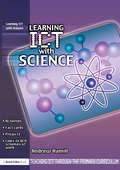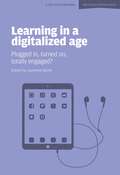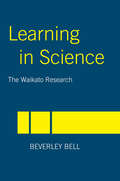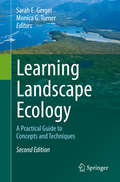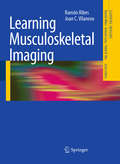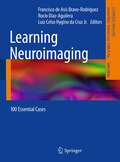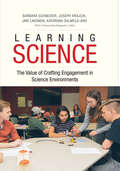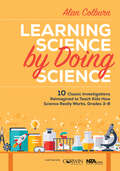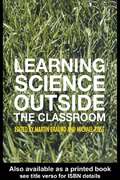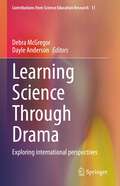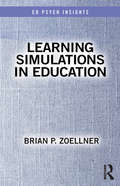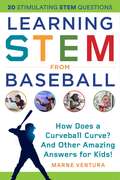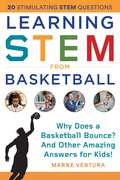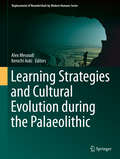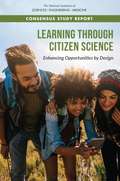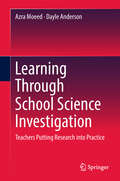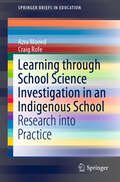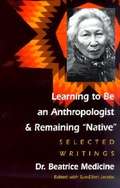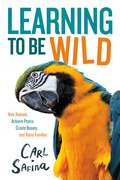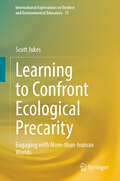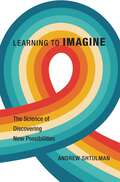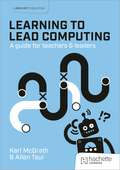- Table View
- List View
Learning ICT with Science (Teaching ICT through the Primary Curriculum)
by Andrew HamillProviding practical guidance on enhancing learning through ICT in science, this book is made up of a series of projects that supplement, augment and extend the QCA ICT scheme and provide much-needed links with Units in other subjects’ schemes of work. It includes: fact cards that support each project and clearly outline its benefits in relation to teaching and learning examples of how activities work in 'real' classrooms links to research, inspection evidence and background reading to support each project adaptable planning examples and practical ideas provided on an accompanying CD ROM. This book is essential reading for all trainee and practising primary teachers.
Learning in a Digitalized Age: Plugged in, Turned on, Totally Engaged? (World Class Schools Ser.)
by Lawrence BurkeAll professional learning communities agree that there is added value in utilizing technologies to enhance and facilitate student success. This volume seeks from us a critical and informed answer to one of the most important educational questions of the day: how successful will learners be in the digital age? Here, writers with real hands-on experience in the field challenge many of the assumptions about teaching and learning in the digital age. It is relevant and important for all those interested and concerned about the kinds of debates, arguments and ideas which are influencing and changing the nature of teaching and learning in the early decades of the 21st century.
Learning in a Digitalized Age: Plugged in, Turned on, Totally Engaged? (World Class Schools Ser.)
by Lawrence BurkeAll professional learning communities agree that there is added value in utilizing technologies to enhance and facilitate student success. This volume seeks from us a critical and informed answer to one of the most important educational questions of the day: how successful will learners be in the digital age? Here, writers with real hands-on experience in the field challenge many of the assumptions about teaching and learning in the digital age. It is relevant and important for all those interested and concerned about the kinds of debates, arguments and ideas which are influencing and changing the nature of teaching and learning in the early decades of the 21st century.
Learning in Science: The Waikato Research
by Beverley BellLearning in Science brings together accounts of the five influential and groundbreaking Learning in Science Projects, undertaken by the author over a period of twenty years. Offering comprehensive coverage of the findings and implications of the projects, the book offers insight and inspiration at all levels of science teaching and learning, from primary and secondary school science, to teacher development, and issues of classroom assessment.The book reviews the findings in the light of current science education, and is thematically organised to illuminate continuous and emerging themes and trends, including:* learning* pedagogy* assessment* Maori and science education * curriculum development as teacher development * and research methodology.Learning in Science will be a valuable resource for science teachers, science teacher educators, science education researchers, curriculum developers and policy makers.
Learning Landscape Ecology
by Sarah E. Gergel Monica G. TurnerThis title meets a great demand for training in spatial analysis tools accessible to a wide audience. Landscape ecology continues to grow as an exciting discipline with much to offer for solving pressing and emerging problems in environmental science. Much of the strength of landscape ecology lies in its ability to address challenges over large areas, over spatial and temporal scales at which decision-making often occurs. As the world tackles issues related to sustainability and global change, the need for this broad perspective has only increased. Furthermore, spatial data and spatial analysis (core methods in landscape ecology) are critical for analyzing land-cover changes world-wide. While spatial dynamics have long been fundamental to terrestrial conservation strategies, land management and reserve design, mapping and spatial themes are increasingly recognized as important for ecosystem management in aquatic, coastal and marine systems. This second edition is purposefully more applied and international in its examples, approaches, perspectives and contributors. It includes new advances in quantifying landscape structure and connectivity (such as graph theory), as well as labs that incorporate the latest scientific understanding of ecosystem services, resilience, social-ecological landscapes, and even seascapes. Of course, as before, the exercises emphasize easy-to-use, widely available software.
Learning Musculoskeletal Imaging
by Joan C. Vilanova Ramón RibesThis introduction to musculoskeletal imaging is a further volume in the Learning Imaging series. Written in a user-friendly format, it takes into account that musculoskeletal radiology is a subspecialty which has widely expanded its scope and imaging capabilities with the advent of ultrasound, MRI, multidetector CT, and PET. The book is divided into ten sections covering: infection and arthritis, tumors, tendons and muscles, bone marrow, spine, shoulder, elbow, hand and wrist, hip and pelvis, knee, and ankle and foot. Each chapter is presented with an introduction and ten case studies with illustrations and comments from anatomical, physiopathological and radiological standpoints along with bibliographic recommendations.
Learning Neuroimaging
by Francisco de Bravo-Rodríguez Luiz Celso Hygino Da Cruz Jr. Rocío Diaz-AguileraThis book is intended as an introduction to neuroradiology and aims to provide the reader with a comprehensive overview of this highly specialized radiological subspecialty. One hundred illustrated cases from clinical practice are presented in a standard way. Each case is supported by representative images and is divided into three parts: a brief summary of the patient's medical history, a discussion of the disease, and a description of the most characteristic imaging features of the disorder. The focus is not only on common neuroradiological entities such as stroke and acute head trauma but also on less frequent disorders that the practitioner should recognize. Learning Neuroimaging: 100 Essential Cases is an ideal resource for neuroradiology and radiology residents, neurology residents, neurosurgery residents, nurses, radiology technicians, and medical students.
Learning Science: The Value of Crafting Engagement in Science Environments
by Barbara Schneider Joseph Krajcik Jari LavonenAn innovative, internationally developed system to help advance science learning and instruction for high school students This book tells the story of a $3.6 million research project funded by the National Science Foundation aimed at increasing scientific literacy and addressing global concerns of declining science engagement. Studying dozens of classrooms across the United States and Finland, this international team combines large-scale studies with intensive interviews from teachers and students to examine how to transform science education. Written for teachers, parents, policymakers, and researchers, this book offers solutions for matching science learning and instruction with newly recommended twenty-first-century standards.
Learning Science by Doing Science: 10 Classic Investigations Reimagined to Teach Kids How Science Really Works, Grades 3-8
by Alan ColburnTime-tested activities to teach the key ideas of science—and turn students into scientists! This witty book adapts classic investigations to help students in grades 3 through 8 truly think and act like scientists. Chapter by chapter, this accessible primer illustrates a “big idea” about the nature of science and offers clear links to the Next Generation Science Standards and its Science and Engineering Practices. You’ll also find: A reader-friendly overview of the NGSS Guidance on adapting the activities to your grade level, including communicating instructions, facilitating discussions, and managing safety concerns Case studies of working scientists to highlight specifics about the science and engineering practices
Learning Science by Doing Science: 10 Classic Investigations Reimagined to Teach Kids How Science Really Works, Grades 3-8
by Alan ColburnTime-tested activities to teach the key ideas of science—and turn students into scientists! This witty book adapts classic investigations to help students in grades 3 through 8 truly think and act like scientists. Chapter by chapter, this accessible primer illustrates a “big idea” about the nature of science and offers clear links to the Next Generation Science Standards and its Science and Engineering Practices. You’ll also find: A reader-friendly overview of the NGSS Guidance on adapting the activities to your grade level, including communicating instructions, facilitating discussions, and managing safety concerns Case studies of working scientists to highlight specifics about the science and engineering practices
Learning Science in the Schools: Research Reforming Practice
by Reinders Duit Shawn M. GlynnScience -- and the technology derived from it -- is having a dramatic impact on the quality of our personal lives and the environment around us. Science will have an even greater impact on the lives of our students. The lives of scientifically literate students will be enriched by their understanding, appreciation, and enjoyment of the natural world. To prosper in the near future, all students must become scientifically literate and embrace the notion of life-long learning in science. Without scientific literacy, it will become impossible for students to make informed decisions about the interrelated educational, scientific, and social issues that will confront them in the future. Intended for science teachers, teacher educators, researchers, and administrators, this volume is concerned with the innovative research that is reforming how science is learned in schools. The chapters provide overviews of current research and illustrate how the findings of this research are being applied in schools. This research-based knowledge is essential for effective science instruction. The contributors are leading authorities in science education and their chapters draw clear connections among research, theory, and classroom practice. They provide excellent examples from science classes in which their research has reformed practice. This book will help educators develop the scientific literacy of students. It bridges the gap between cutting-edge research and classroom practice to provide educators with the knowledge they need to foster students' scientific literacy.
Learning Science Outside the Classroom
by Martin Braund and Michael ReissThis book shows how a wide range of contexts for learning science can be used outside of the classroom, and includes learning: at museums, science centres and planetaria from newspapers, magazines and through ICT at industrial sites and through science trails at zoos, farms, botanic gardens, residential centres and freshwater habitats in school grounds. With contributions from well known and respected practitioners in all fields of science education and through using case studies, Learning Science Outside the Classroom offers practical guidance for teachers, assistant teaching staff and student teachers involved in primary and secondary education. It will help enable them to widen the scientific experience and understanding of pupils. The advice in this book has been checked for safety by CLEAPSS.
Learning Science Through Drama: Exploring international perspectives (Contributions from Science Education Research #11)
by Debra McGregor Dayle AndersonThis book presents a wide range of international perspectives that explore the different ways the diverse forms of drama supports learning in science. It illustrates how learning science by adopting and adapting theatrical techniques can offer more inclusive ways for students to relate to scientific ideas and concepts. The theatrical processes by which subject matter can be introduced, thought about, discussed, transformed, enacted and disseminated are shown to be endless. The first section of the book considers different ways of theorising and applying drama in classrooms. The second section provides a range of case studies illustrating how role play, performance, embodiment and enquiry approaches can be utilised for learning in primary, secondary and tertiary education contexts. The third section demonstrates how different research methods from questionnaires, particular kinds of tests and even the theatrical conventions themselves can provide rich data that informs how drama impacts on learning science.
Learning Simulations in Education (Ed Psych Insights)
by Brian P. ZoellnerTechnology-enabled simulations are increasingly used for students in K-12 education and have the potential to improve teaching and learning across domains. Across five chapters, this book explores the psychological foundation of simulation use in instruction, guiding readers through individual differences among learners and contexts while addressing theory, pedagogy, cognitive processes, and more. This concise volume is designed for any education course that includes simulations in the curriculum and will be indispensable for student researchers and both pre- and in-service teachers alike.
Learning STEM from Baseball: How Does a Curveball Curve? And Other Amazing Answers for Kids! (STEM Sports)
by Marne VenturaGet your sports-loving kid excited about Science, Technology, Engineering, and Math By integrating the thrill of learning into the context of baseball, Learning STEM from Baseball presents a whole new ball game. Unleash the inner scientist, engineer, and mathematician in your child as they learn that sports and STEM aren't so separate after all. You'll both love finding out the answers to questions such as: What's a sweet spot?When was the pitching machine invented?How are baseballs made?How do numbers help baseball players? What are some STEM careers in baseball?And so much more! This easy-to-follow introduction to STEM topics sets kids up to make connections across subjects, discover new facts about baseball, and grow curious about academic fields!
Learning STEM from Basketball: Why Does a Basketball Bounce? And Other Amazing Answers for Kids! (STEM Sports)
by Marne VenturaGet your sports-loving kid excited about Science, Technology, Engineering, and Math By integrating the thrill of learning into the context of basketball, Learning STEM from Basketball presents an educational slam dunk. Unleash the inner scientist, engineer, and mathematician in your child as they learn that sports and STEM aren't so separate after all. You'll both love finding out the answers to questions such as: Why does a basketball bounce?What's a shot clock?Why does a basketball rim have a net?What's the math behind a free throw?And so much more! This easy-to-follow introduction to STEM topics sets kids up to make connections across subjects, discover new facts about basketball, and grow curious about academic fields!
Learning Strategies and Cultural Evolution during the Palaeolithic
by Alex Mesoudi Kenichi AokiThis volume is motivated by the desire to explain why Neanderthals were replaced by modern humans, in terms of cultural differences between the two (sub-) species. It provides up-to-date coverage on the theory of cultural evolution as is being used by anthropologists, archaeologists, biologists and psychologists to decipher hominin cultural change and diversity during the Palaeolithic. The contributing authors are directly involved in this effort and the material presented includes novel approaches and findings. Chapters explain how learning strategies in combination with social and demographic factors (e. g. , population size and mobility patterns) predict cultural evolution in a world without the printing press, television or the Internet. Also addressed is the inverse problem of how learning strategies may be inferred from actual trajectories of cultural change, for example as seen in the North American Palaeolithic. Mathematics and statistics, a sometimes necessary part of theory, are explained in elementary terms where they appear, with details relegated to appendices. Full citations of the relevant literature will help the reader to further pursue any topic of interest.
Learning Through Citizen Science: Enhancing Opportunities By Design
by National Academies of Sciences Engineering MedicineIn the last twenty years, citizen science has blossomed as a way to engage a broad range of individuals in doing science. Citizen science projects focus on, but are not limited to, nonscientists participating in the processes of scientific research, with the intended goal of advancing and using scientific knowledge. A rich range of projects extend this focus in myriad directions, and the boundaries of citizen science as a field are not clearly delineated. Citizen science involves a growing community of professional practitioners, participants, and stakeholders, and a thriving collection of projects. While citizen science is often recognized for its potential to engage the public in science, it is also uniquely positioned to support and extend participants’ learning in science. Contemporary understandings of science learning continue to advance. Indeed, modern theories of learning recognize that science learning is complex and multifaceted. Learning is affected by factors that are individual, social, cultural, and institutional, and learning occurs in virtually any context and at every age. Current understandings of science learning also suggest that science learning extends well beyond content knowledge in a domain to include understanding of the nature and methods of science. Learning Through Citizen Science: Enhancing Opportunities by Design discusses the potential of citizen science to support science learning and identifies promising practices and programs that exemplify the promising practices. This report also lays out a research agenda that can fill gaps in the current understanding of how citizen science can support science learning and enhance science education.
Learning Through School Science Investigation: Teachers Putting Research Into Practice (SpringerBriefs in Education)
by Dayle Anderson Azra MoeedThis book explores teaching and learning through science investigation and practical work. It draws upon two representative case studies from New Zealand and examines what students are learning from science investigation; in addition, it identifies and describes ways in which teachers can make changes that benefit student learning when given time to reflect and respond to research literature and findings. The book illustrates how teaching through science investigations in ways that are informed by research can lead to positive learning outcomes for students. As such, it offers valuable insights for practitioners, researchers, and educators with an interest in learning through science investigation.
Learning Through School Science Investigation in an Indigenous School: Research into Practice (SpringerBriefs in Education)
by Azra Moeed Craig RofeThis book presents the findings of a case study conducted in a Māori medium school where a space was created for Pūtaiao (Western science) teaching and learning from year 1 to 13. Science is currently taught in Te Reo Māori in primary school and in English in secondary school, and evidence suggests that students are engaging in science education, learning to investigate, and achieving in science. In New Zealand, most students attend English medium state schools; however, approximately 15% of indegenous students attend Māori medium schools. These schools are underpinned with Kura Kaupapa Māori philosophy, which is culturally specific to Māori and aims to revitalise the Māori language, and Māori knowledge and culture. Māori students’ engagement and achievement continues to be a challenge for both mainstream and Māori medium schools, teachers and students due to lack of access to science teachers who can teach in Te Reo Māori. School leaders and whanau (families) believed that by year 9 (age 13) their students had developed their identity as Māori, and were proficient in Te Reo Māori. They wanted their students to have the option to learn science, experience success and have the choice to conitnue in science, so they made the difficult decision for science to be taught in English in secondary school. The book discusses how teachers in indigenous schools, who have extensive knowledge of culture and context specific pedagogies, can gain confidence to teach science through collaboration with and support from researchers with whom they have developed strong professional relationships.
Learning to Be an Anthropologist and Remaining "Native"
by Beatrice MedicineNative American anthropologist considers many aspects of life on various Sioux reservations
Learning to Be Wild (A Young Reader's Adaptation): How Animals Achieve Peace, Create Beauty, and Raise Families
by Carl SafinaFrom New York Times-bestselling author Carl Safina comes Learning to Be Wild, a young readers adaptation of the notable book Becoming Wild that explores community, culture, and belonging through the lives of chimpanzees, macaws, and sperm whales.What do chimpanzees, macaws, and whales all have in common?Some believe that culture is strictly a human phenomenon. But that's not true! Culture is passed down from parent to child in all sorts of animal communities. It is the common ground that three very different animals - chimpanzees, macaws, and whales - share.Discover through the lives of chimpanzees in Uganda, scarlet macaws in Peru, and sperm whales in the Caribbean how they - and we - are all connected, in this wonderous journey around the globe.
Learning to Confront Ecological Precarity: Engaging with More-than-human Worlds (International Explorations in Outdoor and Environmental Education #13)
by Scott JukesThis volume presents innovative approaches for confronting environmental issues and socio-ecological inequality within Outdoor Environmental Education (OEE). Through experimentation with alternative pedagogical possibilities, it explores what OEE can do in response to ecological precarity. Drawing upon posthumanist theory, it focuses on the enactment of more-than-human pedagogies that foster affirmative environmental relationships while challenging problematic cultural perspectives. The 12 chapters explore various topics, including place-responsive pedagogies, environmental stories, new materialist theoretical insights and waste education practices, engaging with complex environmental issues such as species extinction and climate change in the context of OEE. This book provides practical examples and conceptual creativity to extend contemporary theoretical currents. It offers innovative pedagogical strategies and methodological insights for OEE. Researchers, students, and practitioners of OEE interested in applying posthumanist ideas to their work will find this volume most interesting.
Learning to Imagine: The Science Of Discovering New Possibilities
by Andrew ShtulmanAn award-winning cognitive scientist offers a counterintuitive guide to cultivating imagination.Imagination is commonly thought to be the special province of youth—the natural companion of free play and the unrestrained vistas of childhood. Then come the deadening routines and stifling regimentation of the adult world, dulling our imaginative powers. In fact, Andrew Shtulman argues, the opposite is true. Imagination is not something we inherit at birth, nor does it diminish with age. Instead, imagination grows as we do, through education and reflection.The science of cognitive development shows that young children are wired to be imitators. When confronted with novel challenges, they struggle to think outside the box, and their creativity is rigidly constrained by what they deem probable, typical, or normal. Of course, children love to “play pretend,” but they are far more likely to simulate real life than to invent fantasy worlds of their own. And they generally prefer the mundane and the tried-and-true to the fanciful or the whimsical.Children’s imaginations are not yet fully formed because they necessarily lack knowledge, and it is precisely knowledge of what is real that provides a foundation for contemplating what might be possible. The more we know, the farther our imaginations can roam. As Learning to Imagine demonstrates, the key to expanding the imagination is not forgetting what you know but learning something new. By building upon the examples of creative minds across diverse fields, from mathematics to religion, we can consciously develop our capacities for innovation and imagination at any age.
Learning to Lead Computing: A guide for teachers and leaders
by Karl McGrath Allen TsuiIn Learning To Lead Computing, Karl McGrath and Allen Tsui provide an essential, jargon-free guide for educators tasked with leading computing at their school. Drawing from over a decade of experience in education, the authors deliver practical advice and strategies to engage and inspire both colleagues and empower them as leaders. This comprehensive handbook offers step-by-step instructions on everything from curriculum sequence to staff motivation, sharing research-backed approaches such as PRIMM and Parsons problems to encourage deeper thinking about computing in the classroom. Karl McGrath and Allen Tsui's approachable style, ensures that even non-specialists can confidently lead computing education. Ideal for ECTs, computing subject leads and senior leaders, this book transforms complex subjects into engaging and manageable content, empowering educators to foster a generation of tech-savvy digital citizens.
